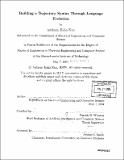| dc.contributor.advisor | Patrick H. Winston. | en_US |
| dc.contributor.author | Kim, Anthony Hahn, 1980- | en_US |
| dc.contributor.other | Massachusetts Institute of Technology. Dept. of Electrical Engineering and Computer Science. | en_US |
| dc.date.accessioned | 2005-09-26T20:25:11Z | |
| dc.date.available | 2005-09-26T20:25:11Z | |
| dc.date.copyright | 2004 | en_US |
| dc.date.issued | 2004 | en_US |
| dc.identifier.uri | http://hdl.handle.net/1721.1/28433 | |
| dc.description | Thesis (M. Eng.)--Massachusetts Institute of Technology, Dept. of Electrical Engineering and Computer Science, 2004. | en_US |
| dc.description | Includes bibliographical references (leaves 81-82). | en_US |
| dc.description.abstract | If we are to understand the innately human ability to solve complex problems, we must first understand the cognitive processes that allow us to combine different kinds of knowledge, to learn new things and to communicate with other people. I have built a computer simulation, based on the work of Simon Kirby, in which I show that a population of induction agents, capable of perceiving their environment and producing utterances, can develop a compositional grammar to describe the world they observe with no prior linguistic knowledge. This system expands the semantic domain proposed by Kirby which expressed meanings such as "John knows Pete" to a physical world of trajectories such as "The boy ran from the tree to the pole". In this new simulation, I demonstrate that a compositional syntax still develops if the level of semantic complexity increases over time. I then argue that using multiple representations decreases the time necessary for a compositional grammar to emerge. | en_US |
| dc.description.statementofresponsibility | by Anthony Hahn Kim. | en_US |
| dc.format.extent | 82 leaves | en_US |
| dc.format.extent | 3357365 bytes | |
| dc.format.extent | 3366134 bytes | |
| dc.format.mimetype | application/pdf | |
| dc.format.mimetype | application/pdf | |
| dc.language.iso | en_US | |
| dc.publisher | Massachusetts Institute of Technology | en_US |
| dc.rights | M.I.T. theses are protected by copyright. They may be viewed from this source for any purpose, but reproduction or distribution in any format is prohibited without written permission. See provided URL for inquiries about permission. | en_US |
| dc.rights.uri | http://dspace.mit.edu/handle/1721.1/7582 | |
| dc.subject | Electrical Engineering and Computer Science. | en_US |
| dc.title | Building a trajectory syntax through language evolution | en_US |
| dc.type | Thesis | en_US |
| dc.description.degree | M.Eng. | en_US |
| dc.contributor.department | Massachusetts Institute of Technology. Department of Electrical Engineering and Computer Science | |
| dc.identifier.oclc | 56994056 | en_US |
